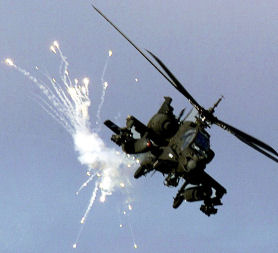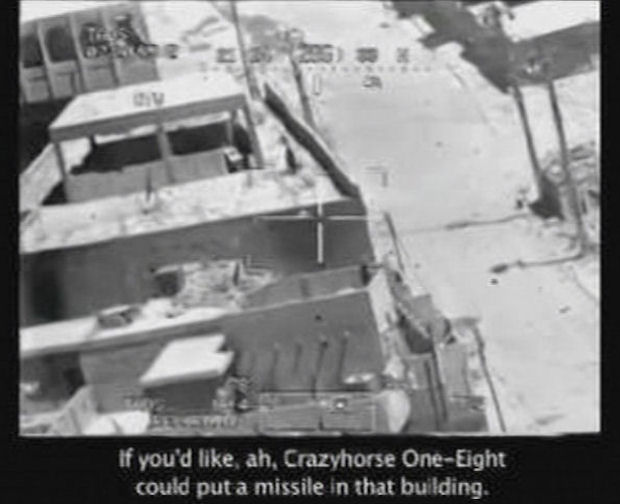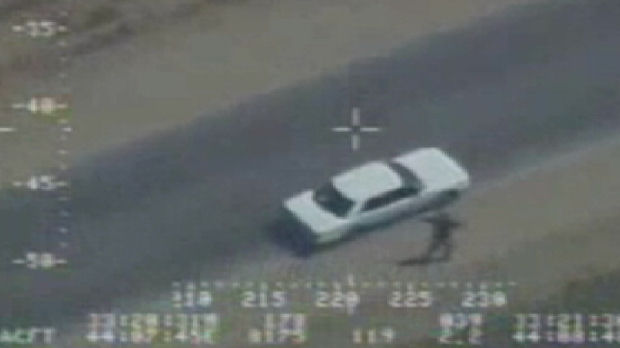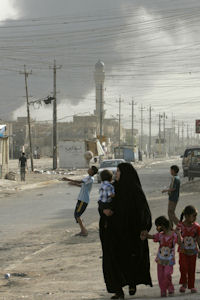Iraq secret war logs: surrender and die
Exclusive: a lawyer tells Channel 4 News there could be evidence of war crimes in the Iraq logs made public by WikiLeaks which contain records of fighters being killed as they try to surrender.

Channel 4 News has accessed the data in the classified documents via The Bureau of Investigative Journalism and WikiLeaks but has been unable to independently verify their authenticity.
Warning: You may find some of the details in this report disturbing.
The Bureau of Investigative Journalism (TBIJ) worked with Channel 4’s Dispatches to analyse nearly 400,000 files, written by US troops during operations in Iraq between 2004 and 2009. Channel 4 News was given unique broadcast access to what they found.
The documents, leaked by an unknown US military source, contain “Sigacts” (significant actions) in which suspected militants trying to surrender to aircraft are fired at and killed by US forces.
Following the publication of the logs, a leading international lawyer has told Channel 4 News that if these records are accurate, there is prima facie evidence of the possibility of war crimes and it should be investigated by the US military.
Secret war files: Afghanistan to Iraq – special report
US Pentagon statement:
Statement from US Pentagon:We deplore WikiLeaks for inducing individuals to break the law, leak classified documents and then cavalierly share that secret information with the world, including our enemies. We know terrorist organizations have been mining the leaked Afghan documents for information to use against us and this Iraq leak is more than four times as large.
By disclosing such sensitive information, WikiLeaks continues to put at risk the lives of our troops, their coalition partners and those Iraqis and Afghans working with us. The only responsible course of action for Wikileaks at this point is to return the stolen material and expunge it from their websites as soon as possible.

US rules of engagement in the Iraq war
The US Rules of Engagement for the Iraq War written in the Law of War handbook 2005, make the clear definition of how US troops should deal with surrendering combatants in Iraq.
In the handbook it states: “Do not engage anyone who has surrendered or is out of battle due to sickness or wounds”.
In Chapter 7 entitled Means and Methods of Warfare, in section b. Hors de Combat it states:
Prohibition against attacking enemy personnel who are “out of combat.” Protected persons:
(1) Prisoners of War. GPW, art. 4, HR, art. 23c,d.
(a) Surrender may be made by any means that communicates the intent to give up. No clear rule as to what constitutes surrender. However, most agree surrender constitutes a cessation of resistance and placement of one’s self at the discretion of the captor.
(b)Captors must respect (not attack) and protect (care for) those who surrender-no reprisals.

Surrender and die
TBIJ and Dispatches analysed numerous Iraq war logs which appeared to show suspected Iraqi combatants being shot down by US aircraft as they tried to surrender.
In a video first broadcast by Live Leak a suspected Iraqi insurgent is followed by an Apache helicopter. On the video we see the vehicle stop, a man gets out and goes onto open ground with his hands held up in the air. We do not know if he is surrendering, but it appears that he is. Moments later he is engaged by the Apache.
If the person is a lawful or unlawful enemy combatant or an Iraqi civilian and that individual is coming out of a vehicle indicating he’s surrendering, he is protected under the Laws of War. Mark Ellis, lawyer
In the Iraq war log of this incident it makes no mention of the Iraqi trying to surrender or getting out of his vehicle.
The Iraq war log says: “CAS call-sign “Big Gun 74” on scene and picks up pursuit. After positive identification from UAV, “Big Gun 74″ given authorisation to engage the vehicle. Vehicle engaged and destroyed at ###### ####. 1 x AIF KIA (Anti-Iraqi force killed in action) on side of road.”
Channel 4 News asked Executive Director of the International Bar Association Mark Ellis, an expert on international law, if US forces could legally engage on Iraqis if they appeared to be surrendering.
He said: “If the person is a lawful or unlawful enemy combatant or an Iraqi civilian and that individual is coming out of a vehicle indicating he’s surrendering, he is protected under the Laws of War.
“In either scenario, if the individual is surrendering he is protected.
“This would apply to an Apache helicopter, which is focusing on one individual coming out of a vehicle indicating he’s surrendering. Again, the pilot would need to be cautious.
“Both scenarios would incorporate subjective assessments by the pilot of what is occurring at that moment. The circumstances of the incident would need to be reviewed and assessed. There would have to be investigation into this. My only issue is if the US military decides not to investigate, because it appears from the details I’ve heard, that there is prima facie evidence for an investigation of a possible war crime.”

Surrender and die: Crazyhorse 18
In another incident TBIJ and Dispatches found an entry wjhere US troops had noted Iraqis “wanting to surrender”.
The pilot questions if he can “engage” and the military lawyer tells him he can. The pilot of the Apache then fires, killing two men.
In the Iraq war log it states: “Crazyhorse 18 reports AIF (Anti-Iraqi forces) got into a dumptruck headed north, engaged and then they came out wanting to surrender.
“Crazyhorse 18 cleared to engage dumptruck. #### lawyer states they can not surrender to aircraft and are still valid targets.
“Crazyhorse 18 reports they missed with hellfire and individuals have ran into another shack.
“### approves Crazyhorse 18 to engage shack.
“Crazyhorse 18 reports engaged and destroyed shack with 2 x AIF (Anti-Iraqi forces). BDA is shack/dumptruck destroyed.”
It then concludes “2 x AIF KIA”, which is two Anti-Iraqi forces killed in action.

So the Iraq war log clearly shows that the pilot thought the Iraqis were trying to surrender. He asked what he was able to do and the call came back from a lawyer to engage with the Iraqis because “they can not surrender to aircraft and are still valid targets”.
Mark Ellis told Channel 4 News: “With regards to surrendering to an aircraft, if an Apache has its sights on an individual who the pilot has been moving against and following and then the individual moves out of the vehicle, indicating to the pilot that he is surrendering, then this scenario would require the pilot to pull back.
“I’m fascinated that in one of the war logs the pilot appears to be engaging with and getting legal advice from military lawyers of the situation. It indicates how far things have advanced and I think it’s a very positive assessment. It helps the pilot determine if what he’s about to do is a legitimate act.
“However, it doesn’t make sense to me for the lawyer to make a distinction of how the individual can surrender (eg. surrendering to an aircraft). I think the lawyer’s assessment that ‘the individual in sight cannot surrender to an aircraft’ and thus ‘is still a valid target’, doesn’t sound right.
“The Laws of War put the onus on the surrendering party to make his intentions ‘clear, unambiguous, and unequivocal to the capturing unit’. If the Apache pilot thought the individual was surrendering, whether to a soldier, a tank or an aircraft, the individual is protected and cannot be engaged.”
Hellfire air attacks: surrender and live?
In some of the Iraq war logs there is also evidence that coalition aircraft held back from firing or engaging with Iraqis who appeared to be surrendering. So is there are logs which contradict one another.
In one report is says: “## ## engaged the white truck with 8 rockets vicinity grid ## #### ####. The 2 x LNs (local nationals) got out of the truck and surrendered to ## ##. #######, alternate QRF (quick reaction force), responded and detained the 2 x LNs.”
So here the Iraqis have surrendered and are not being targeted by the aircraft.
I think the lawyer’s assessment that ‘the individual in sight cannot surrender to an aircraft’ and thus ‘is still a valid target’, doesn’t sound right. Mark Ellis, lawyer
Another Iraq war log states: “SWT (Scout weapons team) (#######) was cleared to engage the remaining pax (person). The pax was wounded and surrendered. ####### and EOD (explosive ordnance disposal) moved on scene and detained the IN ACTION’>EWIA (enemy wounded in action).
Again the injured Iraqi surrenders and the coalition forces detain him rather than kill him.
Finally, another war log reads: “3x IN IRAQ’>AQI/ISI (three al Qaeda in Iraq insurgents) that fled to the north on a white motorcycle. Carnage 26 (SWT) (Scout weapons team), and Wicked 51 (Airscan) maintained PID (positive identification) of the 3x IN IRAQ’>AQI/ISI, SWT was then cleared to engage upon confirmation of IN IRAQ’>AQI/ISI. The engagement resulted in 2x IN IRAQ’>AQI/ISI KIA (two al Qaeda insurgents killed in action), and
1x IN IRAQ’>AQI/ISI surrendering (one al Qaeda in Iraq insurgent surrendering).
“SWT maintained visual apprehension of the 1x IN IRAQ’>AQI/ISI until CF (coalition forces) arrived at their location to detain the IN IRAQ’>AQI/ISI.”
So two al-Qaeda insurgents are killed by the coalition forces aircraft, but one survives, surrenders and is detained.




